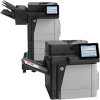HP Color LaserJet Enterprise MFP M680 User Guide 1 - Page 165
Step two: Check the environment, Step three: Set the individual tray alignment
 |
View all HP Color LaserJet Enterprise MFP M680 manuals
Add to My Manuals
Save this manual to your list of manuals |
Page 165 highlights
● Use paper that is designed for use in laser printers. Do not use paper that is designed only for use in Inkjet printers. ● Use paper that is not too rough. Using smoother paper generally results in better print quality. Step two: Check the environment The environment can directly affect print quality and is a common cause for print-quality or paper-feeding issues. Try the following solutions: ● Move the product away from drafty locations, such as open windows or doors, or air-conditioning vents. ● Make sure the product is not exposed to temperatures or humidity outside of product specifications. ● Do not place the product in a confined space, such as a cabinet. ● Place the product on a sturdy, level surface. ● Remove anything that is blocking the vents on the product. The product requires good air flow on all sides, including the top. ● Protect the product from airborne debris, dust, steam, grease, or other elements that can leave residue inside the product. Step three: Set the individual tray alignment Follow these steps when text or images are not centered or aligned correctly on the printed page when printing from specific trays. 1. From the Home screen on the product control panel, scroll to and touch the Administration button. 2. Open the following menus: ● General Settings ● Print Quality ● Image Registration 3. Select the tray that you want to adjust. 4. Touch the Print Test Page button, and then follow the instructions on the printed pages. 5. Touch the Print Test Page button to verify the results, and then make further adjustments if necessary. 6. When you are satisfied with the results, touch the Save button to save the new settings. Calibrate the product to align the colors Calibration is a product function that optimizes print quality. Follow these steps to resolve print print-quality problems such as misaligned color, colored shadows, blurry graphics, or other print-quality issues. 1. From the Home screen on the product control panel, scroll to and touch the Device Maintenance button. 2. Open the following menus: ENWW Improve print quality 153















